2019 MERCEDES-BENZ GLA lights
[x] Cancel search: lightsPage 30 of 346

Information about the REACH decree
The REACH regulation (Regulation (EC) no.1907/2006, Article 33) lays down an informa-tion obligation for substances of very high con-cern (SVHC).
Daimler AG acts in good faith to avoid usingthese SVHCs and to allow the customer tohandle these substances safely. In accordancewith supplier information and internal productinformation from Daimler AG, SVHCs thataccount for more than 0.1 percent by weightof individual products in this vehicle areknown.
More detailed information can be found at thefollowing addresses:
Rhttp://www.daimler.com/reach(Germanversion)
Rhttp://www.daimler.com/reach/en(English version)
Problems with your vehicle
If you should experience a problem with yourvehicle, particularly one that you believe mayaffect its safe operation, we urge you to con-tact an authorized Mercedes-Benz Centerimmediately to have the problem diagnosedand rectified. If the problem is not resolved toyour satisfaction, please discuss the problemagain with an authorized Mercedes-Benz Cen-ter or, if necessary, contact us at one of thefollowing addresses.
In the USA
Mercedes-Benz USA, LLC
Customer Assistance Center
One Mercedes-Benz Drive
Sandy Springs, GA 30328
In Canada
Mercedes-Benz Canada, Inc.
Customer Relations Department
98 Vanderhoof Avenue
Toronto, Ontario M4G 4C9
Limited Warranty
!Observe the notes in this Operator's Man-ual regarding the correct operation of yourvehicle and possible damage to the vehicle.Damage to the vehicle which is caused by
violation of these notes is not covered bythe Mercedes-Benz implied warranty or thenew or used-vehicle warranty.
QR code for rescue card
The QR codes are secured in the fuel filler flapand on the opposite side on the B-pillar. In theevent of an accident, rescue services can usethe QR code to quickly find the appropriaterescue card for your vehicle. The current res-cue card contains the most important informa-tion about your vehicle in a compact form, e.g.the routing of the electric cables.
You can find more information underwww.mercedes-benz.de/qr-code.
Data storage
Data storage
A wide range of electronic components in yourvehicle contain data memories.
These data memories temporarily or perma-nently store technical information about:
Rthe vehicle's operating state
Rincidents
Rmalfunctions
In general, this technical information docu-ments the state of a component, a module, asystem or the surroundings.
These include, for example:
Roperating conditions of system components.For example, fluid levels
Rthe vehicle's status messages and those ofits individual components, e.g. number ofwheel revolutions/speed, deceleration inmovement, lateral acceleration, acceleratorpedal position
Rmalfunctions and defects in important sys-tem components, e.g. lights, brakes
Rvehicle reactions and operating conditionsin special driving situations, e.g. air bagdeployment, intervention of stability controlsystems
Rambient conditions, e.g. outside tempera-ture
28Data storage
Int roduction
Page 42 of 346
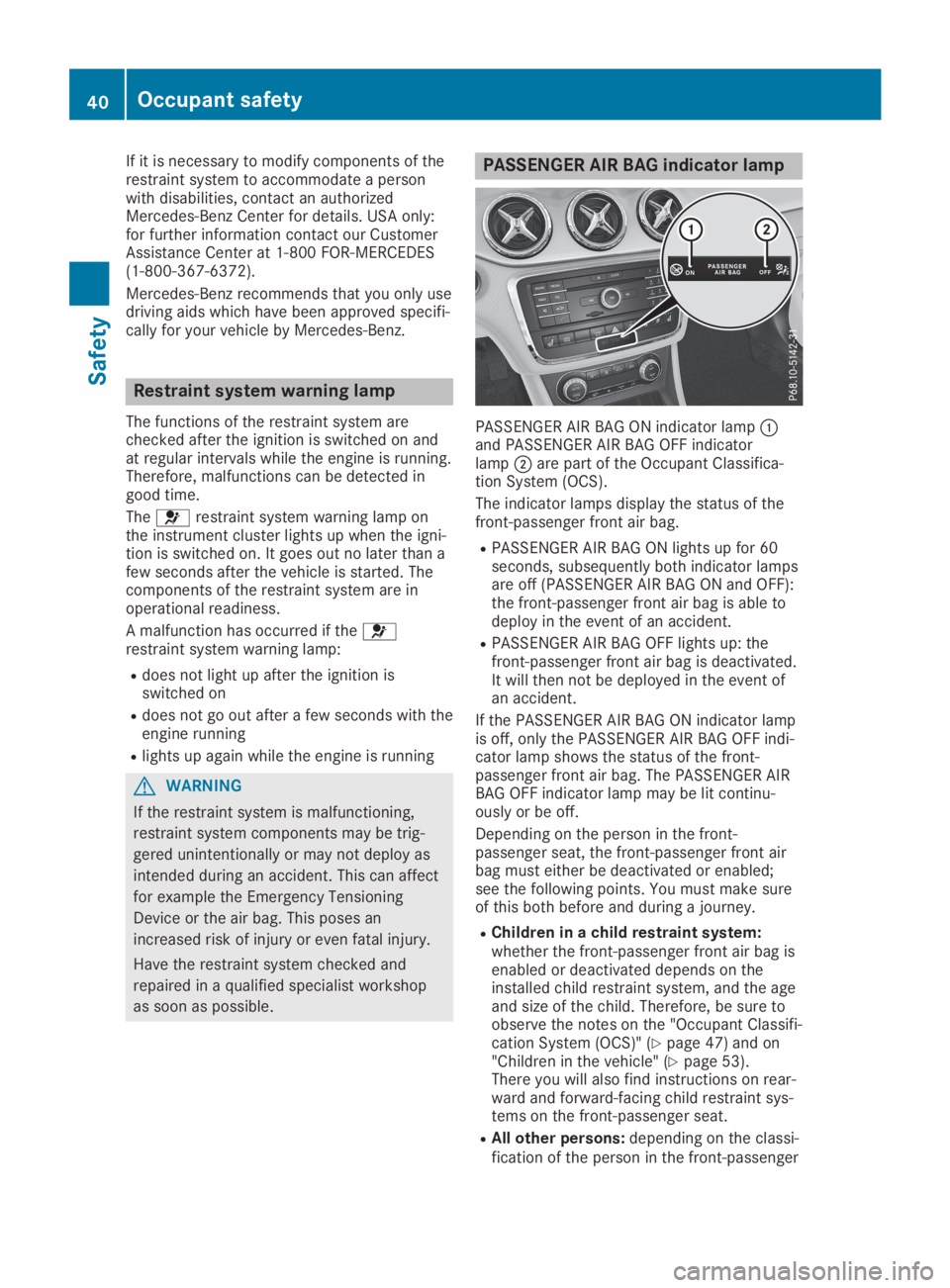
If it is necessary to modify components of therestraint system to accommodate a personwith disabilities, contact an authorizedMercedes-Benz Center for details. USA only:for further information contact our CustomerAssistance Center at 1-800 FOR-MERCEDES(1‑800‑367‑6372).
Mercedes-Benz recommends that you only usedriving aids which have been approved specifi-cally for your vehicle by Mercedes-Benz.
Restraint system warning lamp
The functions of the restraint system arechecked after the ignition is switched on andat regular intervals while the engine is running.Therefore, malfunctions can be detected ingood time.
The�urestraint system warning lamp onthe instrument cluster lights up when the igni-tion is switched on. It goes out no later than afew seconds after the vehicle is started. Thecomponents of the restraint system are inoperational readiness.
A malfunction has occurred if the�urestraint system warning lamp:
Rdoes not light up after the ignition isswitched on
Rdoes not go out after a few seconds with theengine running
Rlights up again while the engine is running
GWARNING
If the restraint system is malfunctioning,
restraint system components may be trig-
gered unintentionally or may not deploy as
intended during an accident. This can affect
for example the Emergency Tensioning
Device or the air bag. This poses an
increased risk of injury or even fatal injury.
Have the restraint system checked and
repaired in a qualified specialist workshop
as soon as possible.
PASSENGER AIR BAG indicator lamp
PASSENGER AIR BAG ON indicator lamp�Cand PASSENGER AIR BAG OFF indicatorlamp�Dare part of the Occupant Classifica-tion System (OCS).
The indicator lamps display the status of thefront-passenger front air bag.
RPASSENGER AIR BAG ON lights up for 60seconds, subsequently both indicator lampsare off (PASSENGER AIR BAG ON and OFF):the front-passenger front air bag is able todeploy in the event of an accident.
RPASSENGER AIR BAG OFF lights up: thefront-passenger front air bag is deactivated.It will then not be deployed in the event ofan accident.
If the PASSENGER AIR BAG ON indicator lampis off, only the PASSENGER AIR BAG OFF indi-cator lamp shows the status of the front-passenger front air bag. The PASSENGER AIRBAG OFF indicator lamp may be lit continu-ously or be off.
Depending on the person in the front-passenger seat, the front-passenger front airbag must either be deactivated or enabled;see the following points. You must make sureof this both before and during a journey.
RChildren in a child restraint system:whether the front-passenger front air bag isenabled or deactivated depends on theinstalled child restraint system, and the ageand size of the child. Therefore, be sure toobserve the notes on the "Occupant Classifi-cation System (OCS)" (Ypage 47) and on"Children in the vehicle" (Ypage 53).There you will also find instructions on rear-ward and forward-facing child restraint sys-tems on the front-passenger seat.
RAll other persons:depending on the classi-fication of the person in the front-passenger
40Occupant safety
Safety
Page 46 of 346
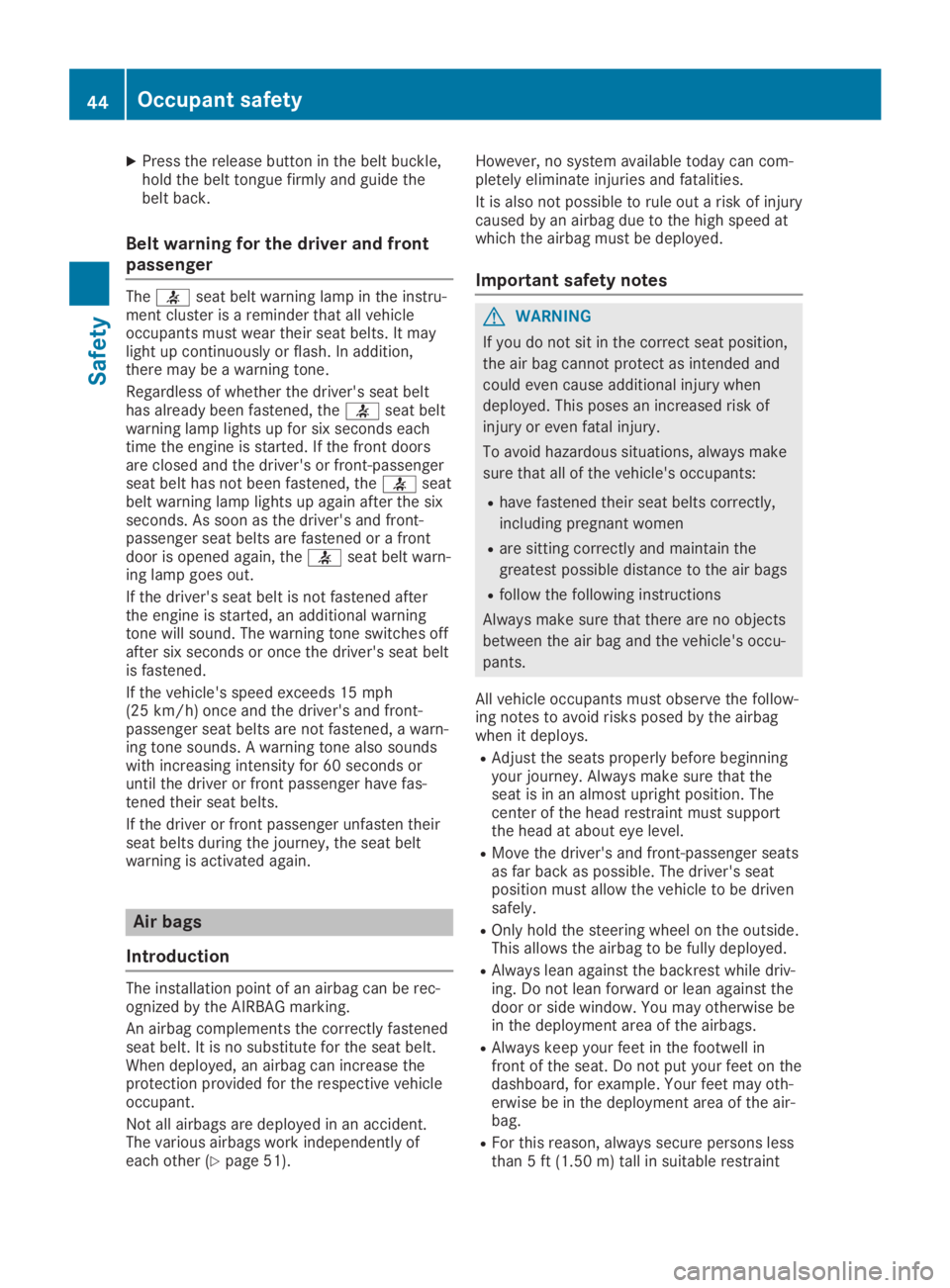
XPress the release button in the belt buckle,hold the belt tongue firmly and guide thebelt back.
Belt warning for the driver and front
passenger
The�vseat belt warning lamp in the instru-ment cluster is a reminder that all vehicleoccupants must wear their seat belts. It maylight up continuously or flash. In addition,there may be a warning tone.
Regardless of whether the driver's seat belthas already been fastened, the�vseat beltwarning lamp lights up for six seconds eachtime the engine is started. If the front doorsare closed and the driver's or front-passengerseat belt has not been fastened, the�vseatbelt warning lamp lights up again after the sixseconds. As soon as the driver's and front-passenger seat belts are fastened or a frontdoor is opened again, the�vseat belt warn-ing lamp goes out.
If the driver's seat belt is not fastened afterthe engine is started, an additional warningtone will sound. The warning tone switches offafter six seconds or once the driver's seat beltis fastened.
If the vehicle's speed exceeds 15 mph(25 km/h) once and the driver's and front-passenger seat belts are not fastened, a warn-ing tone sounds. A warning tone also soundswith increasing intensity for 60 seconds oruntil the driver or front passenger have fas-tened their seat belts.
If the driver or front passenger unfasten theirseat belts during the journey, the seat beltwarning is activated again.
Air bags
Introduction
The installation point of an airbag can be rec-ognized by the AIRBAG marking.
An airbag complements the correctly fastenedseat belt. It is no substitute for the seat belt.When deployed, an airbag can increase theprotection provided for the respective vehicleoccupant.
Not all airbags are deployed in an accident.The various airbags work independently ofeach other (Ypage 51).
However, no system available today can com-pletely eliminate injuries and fatalities.
It is also not possible to rule out a risk of injurycaused by an airbag due to the high speed atwhich the airbag must be deployed.
Important safety notes
GWARNING
If you do not sit in the correct seat position,
the air bag cannot protect as intended and
could even cause additional injury when
deployed. This poses an increased risk of
injury or even fatal injury.
To avoid hazardous situations, always make
sure that all of the vehicle's occupants:
Rhave fastened their seat belts correctly,
including pregnant women
Rare sitting correctly and maintain the
greatest possible distance to the air bags
Rfollow the following instructions
Always make sure that there are no objects
between the air bag and the vehicle's occu-
pants.
All vehicle occupants must observe the follow-ing notes to avoid risks posed by the airbagwhen it deploys.
RAdjust the seats properly before beginningyour journey. Always make sure that theseat is in an almost upright position. Thecenter of the head restraint must supportthe head at about eye level.
RMove the driver's and front-passenger seatsas far back as possible. The driver's seatposition must allow the vehicle to be drivensafely.
ROnly hold the steering wheel on the outside.This allows the airbag to be fully deployed.
RAlways lean against the backrest while driv-ing. Do not lean forward or lean against thedoor or side window. You may otherwise bein the deployment area of the airbags.
RAlways keep your feet in the footwell infront of the seat. Do not put your feet on thedashboard, for example. Your feet may oth-erwise be in the deployment area of the air-bag.
RFor this reason, always secure persons lessthan 5 ft (1.50 m) tall in suitable restraint
44Occupant safety
Safety
Page 50 of 346
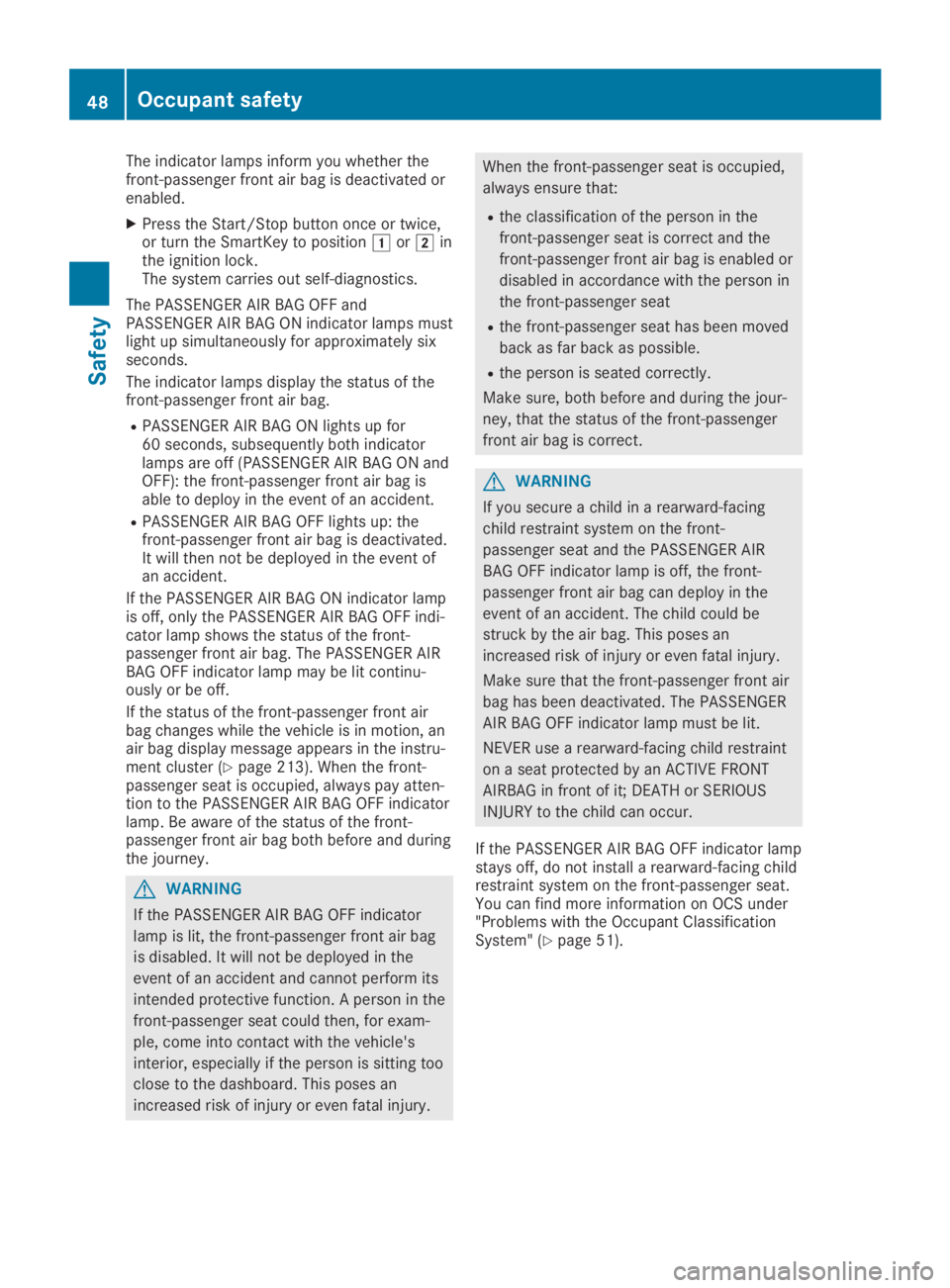
The indicator lamps inform you whether thefront-passenger front air bag is deactivated orenabled.
XPress the Start/Stop button once or twice,or turn the SmartKey to position�Gor�Hinthe ignition lock.The system carries out self-diagnostics.
The PASSENGER AIR BAG OFF andPASSENGER AIR BAG ON indicator lamps mustlight up simultaneously for approximately sixseconds.
The indicator lamps display the status of thefront-passenger front air bag.
RPASSENGER AIR BAG ON lights up for60 seconds, subsequently both indicatorlamps are off (PASSENGER AIR BAG ON andOFF): the front-passenger front air bag isable to deploy in the event of an accident.
RPASSENGER AIR BAG OFF lights up: thefront-passenger front air bag is deactivated.It will then not be deployed in the event ofan accident.
If the PASSENGER AIR BAG ON indicator lampis off, only the PASSENGER AIR BAG OFF indi-cator lamp shows the status of the front-passenger front air bag. The PASSENGER AIRBAG OFF indicator lamp may be lit continu-ously or be off.
If the status of the front-passenger front airbag changes while the vehicle is in motion, anair bag display message appears in the instru-ment cluster (Ypage 213). When the front-passenger seat is occupied, always pay atten-tion to the PASSENGER AIR BAG OFF indicatorlamp. Be aware of the status of the front-passenger front air bag both before and duringthe journey.
GWARNING
If the PASSENGER AIR BAG OFF indicator
lamp is lit, the front-passenger front air bag
is disabled. It will not be deployed in the
event of an accident and cannot perform its
intended protective function. A person in the
front-passenger seat could then, for exam-
ple, come into contact with the vehicle's
interior, especially if the person is sitting too
close to the dashboard. This poses an
increased risk of injury or even fatal injury.
When the front-passenger seat is occupied,
always ensure that:
Rthe classification of the person in the
front-passenger seat is correct and the
front-passenger front air bag is enabled or
disabled in accordance with the person in
the front-passenger seat
Rthe front-passenger seat has been moved
back as far back as possible.
Rthe person is seated correctly.
Make sure, both before and during the jour-
ney, that the status of the front-passenger
front air bag is correct.
GWARNING
If you secure a child in a rearward-facing
child restraint system on the front-
passenger seat and the PASSENGER AIR
BAG OFF indicator lamp is off, the front-
passenger front air bag can deploy in the
event of an accident. The child could be
struck by the air bag. This poses an
increased risk of injury or even fatal injury.
Make sure that the front-passenger front air
bag has been deactivated. The PASSENGER
AIR BAG OFF indicator lamp must be lit.
NEVER use a rearward-facing child restraint
on a seat protected by an ACTIVE FRONT
AIRBAG in front of it; DEATH or SERIOUS
INJURY to the child can occur.
If the PASSENGER AIR BAG OFF indicator lampstays off, do not install a rearward-facing childrestraint system on the front-passenger seat.You can find more information on OCS under"Problems with the Occupant ClassificationSystem" (Ypage 51).
48Occupant safety
Safety
Page 51 of 346
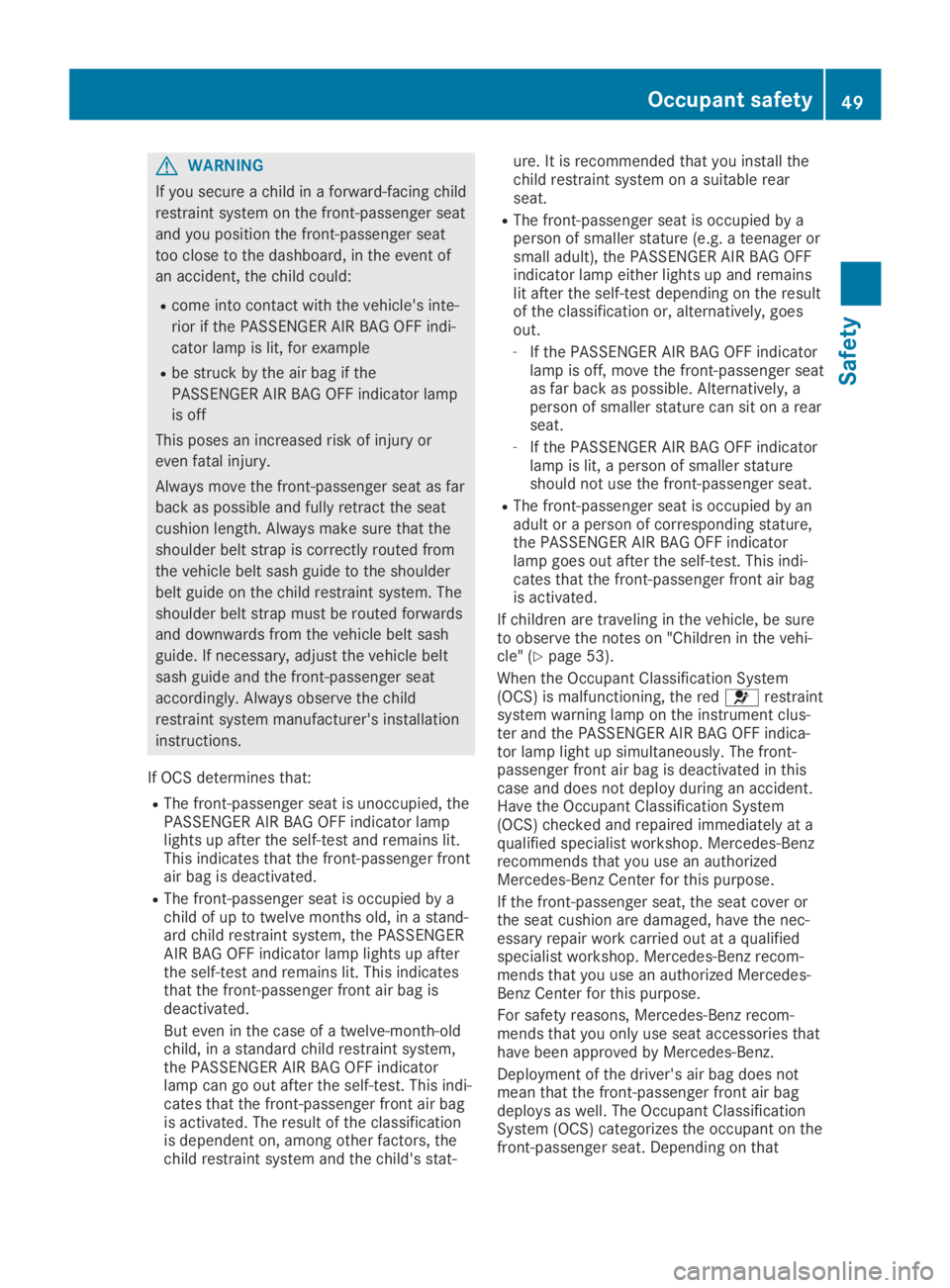
GWARNING
If you secure a child in a forward-facing child
restraint system on the front-passenger seat
and you position the front-passenger seat
too close to the dashboard, in the event of
an accident, the child could:
Rcome into contact with the vehicle's inte-
rior if the PASSENGER AIR BAG OFF indi-
cator lamp is lit, for example
Rbe struck by the air bag if the
PASSENGER AIR BAG OFF indicator lamp
is off
This poses an increased risk of injury or
even fatal injury.
Always move the front-passenger seat as far
back as possible and fully retract the seat
cushion length. Always make sure that the
shoulder belt strap is correctly routed from
the vehicle belt sash guide to the shoulder
belt guide on the child restraint system. The
shoulder belt strap must be routed forwards
and downwards from the vehicle belt sash
guide. If necessary, adjust the vehicle belt
sash guide and the front-passenger seat
accordingly. Always observe the child
restraint system manufacturer's installation
instructions.
If OCS determines that:
RThe front-passenger seat is unoccupied, thePASSENGER AIR BAG OFF indicator lamplights up after the self-test and remains lit.This indicates that the front-passenger frontair bag is deactivated.
RThe front-passenger seat is occupied by achild of up to twelve months old, in a stand-ard child restraint system, the PASSENGERAIR BAG OFF indicator lamp lights up afterthe self-test and remains lit. This indicatesthat the front-passenger front air bag isdeactivated.
But even in the case of a twelve-month-oldchild, in a standard child restraint system,the PASSENGER AIR BAG OFF indicatorlamp can go out after the self-test. This indi-cates that the front-passenger front air bagis activated. The result of the classificationis dependent on, among other factors, thechild restraint system and the child's stat-
ure. It is recommended that you install thechild restraint system on a suitable rearseat.
RThe front-passenger seat is occupied by aperson of smaller stature (e.g. a teenager orsmall adult), the PASSENGER AIR BAG OFFindicator lamp either lights up and remainslit after the self-test depending on the resultof the classification or, alternatively, goesout.
-If the PASSENGER AIR BAG OFF indicatorlamp is off, move the front-passenger seatas far back as possible. Alternatively, aperson of smaller stature can sit on a rearseat.
-If the PASSENGER AIR BAG OFF indicatorlamp is lit, a person of smaller statureshould not use the front-passenger seat.
RThe front-passenger seat is occupied by anadult or a person of corresponding stature,the PASSENGER AIR BAG OFF indicatorlamp goes out after the self-test. This indi-cates that the front-passenger front air bagis activated.
If children are traveling in the vehicle, be sureto observe the notes on "Children in the vehi-cle" (Ypage 53).
When the Occupant Classification System(OCS) is malfunctioning, the red�urestraintsystem warning lamp on the instrument clus-ter and the PASSENGER AIR BAG OFF indica-tor lamp light up simultaneously. The front-passenger front air bag is deactivated in thiscase and does not deploy during an accident.Have the Occupant Classification System(OCS) checked and repaired immediately at aqualified specialist workshop. Mercedes-Benzrecommends that you use an authorizedMercedes-Benz Center for this purpose.
If the front-passenger seat, the seat cover orthe seat cushion are damaged, have the nec-essary repair work carried out at a qualifiedspecialist workshop. Mercedes-Benz recom-mends that you use an authorized Mercedes-Benz Center for this purpose.
For safety reasons, Mercedes-Benz recom-mends that you only use seat accessories thathave been approved by Mercedes-Benz.
Deployment of the driver's air bag does notmean that the front-passenger front air bagdeploys as well. The Occupant ClassificationSystem (OCS) categorizes the occupant on thefront-passenger seat. Depending on that
Occupant safety49
Safety
Z
Page 52 of 346
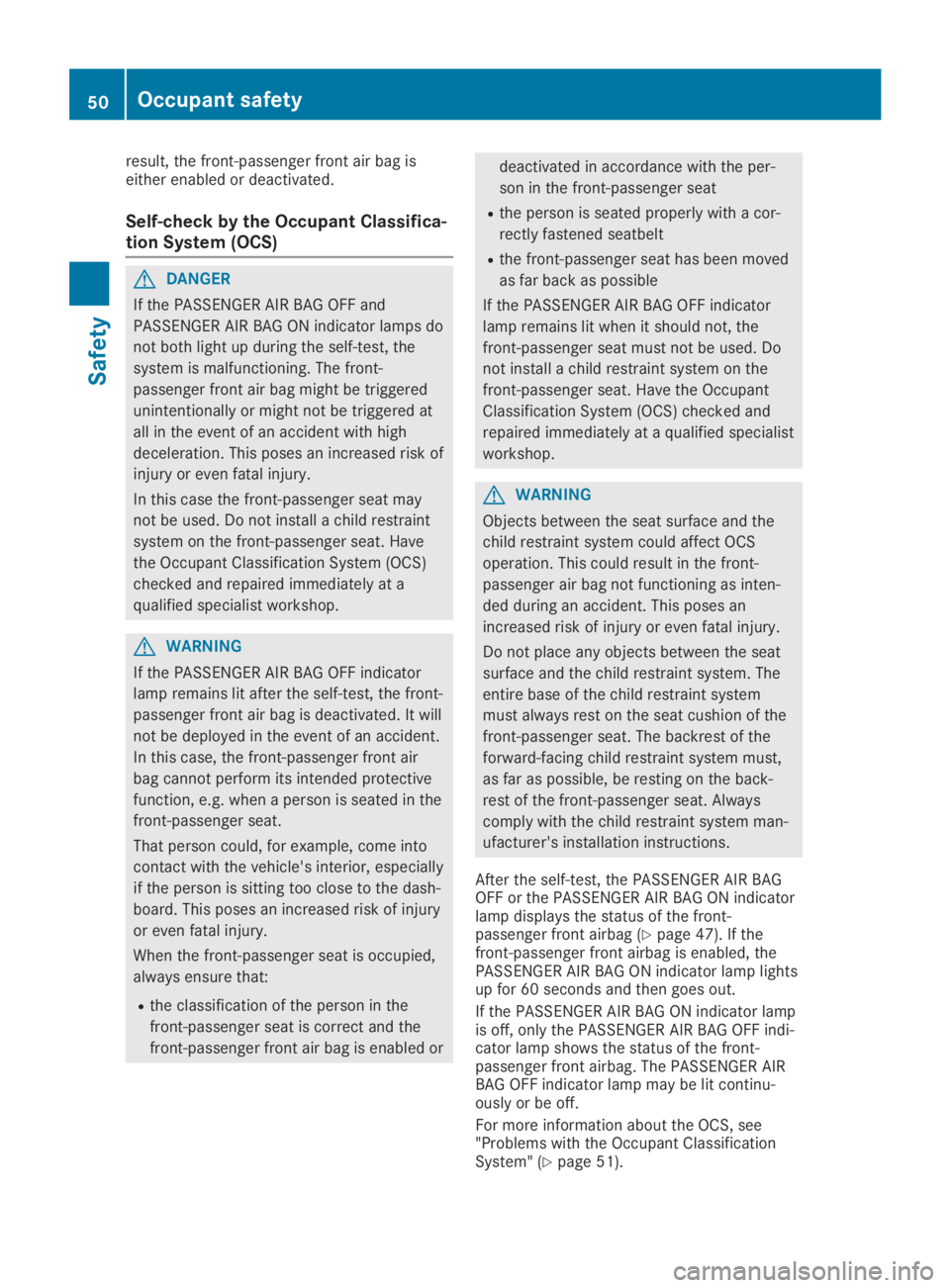
result, the front-passenger front air bag iseither enabled or deactivated.
Self-check by the Occupant Classifica-
tion System (OCS)
GDANGER
If the PASSENGER AIR BAG OFF and
PASSENGER AIR BAG ON indicator lamps do
not both light up during the self-test, the
system is malfunctioning. The front-
passenger front air bag might be triggered
unintentionally or might not be triggered at
all in the event of an accident with high
deceleration. This poses an increased risk of
injury or even fatal injury.
In this case the front-passenger seat may
not be used. Do not install a child restraint
system on the front-passenger seat. Have
the Occupant Classification System (OCS)
checked and repaired immediately at a
qualified specialist workshop.
GWARNING
If the PASSENGER AIR BAG OFF indicator
lamp remains lit after the self-test, the front-
passenger front air bag is deactivated. It will
not be deployed in the event of an accident.
In this case, the front-passenger front air
bag cannot perform its intended protective
function, e.g. when a person is seated in the
front-passenger seat.
That person could, for example, come into
contact with the vehicle's interior, especially
if the person is sitting too close to the dash-
board. This poses an increased risk of injury
or even fatal injury.
When the front-passenger seat is occupied,
always ensure that:
Rthe classification of the person in the
front-passenger seat is correct and the
front-passenger front air bag is enabled or
deactivated in accordance with the per-
son in the front-passenger seat
Rthe person is seated properly with a cor-
rectly fastened seatbelt
Rthe front-passenger seat has been moved
as far back as possible
If the PASSENGER AIR BAG OFF indicator
lamp remains lit when it should not, the
front-passenger seat must not be used. Do
not install a child restraint system on the
front-passenger seat. Have the Occupant
Classification System (OCS) checked and
repaired immediately at a qualified specialist
workshop.
GWARNING
Objects between the seat surface and the
child restraint system could affect OCS
operation. This could result in the front-
passenger air bag not functioning as inten-
ded during an accident. This poses an
increased risk of injury or even fatal injury.
Do not place any objects between the seat
surface and the child restraint system. The
entire base of the child restraint system
must always rest on the seat cushion of the
front-passenger seat. The backrest of the
forward-facing child restraint system must,
as far as possible, be resting on the back-
rest of the front-passenger seat. Always
comply with the child restraint system man-
ufacturer's installation instructions.
After the self-test, the PASSENGER AIR BAGOFF or the PASSENGER AIR BAG ON indicatorlamp displays the status of the front-passenger front airbag (Ypage 47). If thefront-passenger front airbag is enabled, thePASSENGER AIR BAG ON indicator lamp lightsup for 60 seconds and then goes out.
If the PASSENGER AIR BAG ON indicator lampis off, only the PASSENGER AIR BAG OFF indi-cator lamp shows the status of the front-passenger front airbag. The PASSENGER AIRBAG OFF indicator lamp may be lit continu-ously or be off.
For more information about the OCS, see"Problems with the Occupant ClassificationSystem" (Ypage 51).
50Occupant safety
Safety
Page 53 of 346
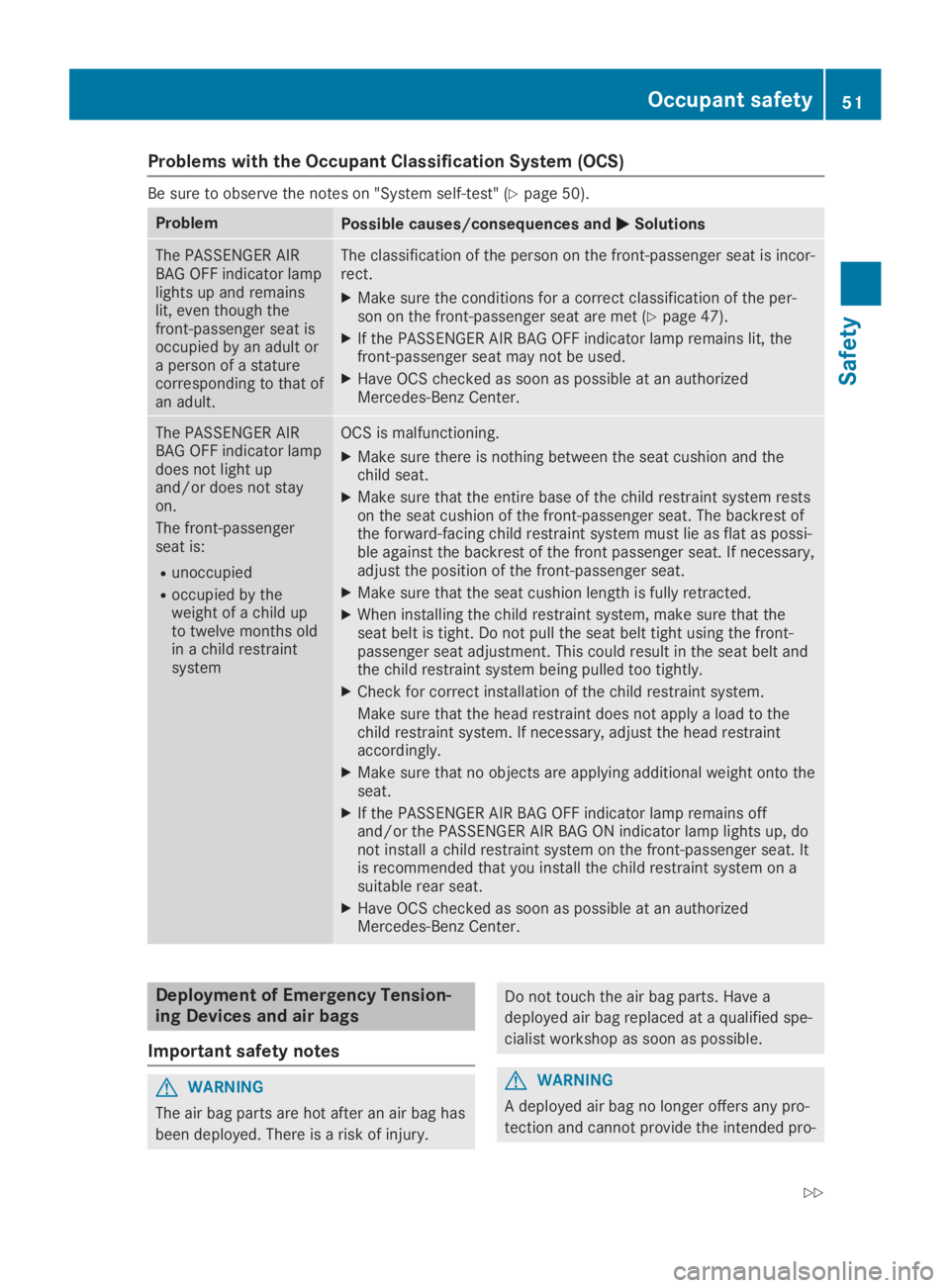
Problems with the Occupant Classification System (OCS)
Be sure to observe the notes on "System self-test" (Ypage 50).
ProblemPossible causes/consequences and�P�PSolutions
The PASSENGER AIRBAG OFF indicator lamplights up and remainslit, even though thefront-passenger seat isoccupied by an adult ora person of a staturecorresponding to that ofan adult.
The classification of the person on the front-passenger seat is incor-rect.
XMake sure the conditions for a correct classification of the per-son on the front-passenger seat are met (Ypage 47).
XIf the PASSENGER AIR BAG OFF indicator lamp remains lit, thefront-passenger seat may not be used.
XHave OCS checked as soon as possible at an authorizedMercedes-Benz Center.
The PASSENGER AIRBAG OFF indicator lampdoes not light upand/or does not stayon.
The front-passengerseat is:
Runoccupied
Roccupied by theweight of a child upto twelve months oldin a child restraintsystem
OCS is malfunctioning.
XMake sure there is nothing between the seat cushion and thechild seat.
XMake sure that the entire base of the child restraint system restson the seat cushion of the front-passenger seat. The backrest ofthe forward-facing child restraint system must lie as flat as possi-ble against the backrest of the front passenger seat. If necessary,adjust the position of the front-passenger seat.
XMake sure that the seat cushion length is fully retracted.
XWhen installing the child restraint system, make sure that theseat belt is tight. Do not pull the seat belt tight using the front-passenger seat adjustment. This could result in the seat belt andthe child restraint system being pulled too tightly.
XCheck for correct installation of the child restraint system.
Make sure that the head restraint does not apply a load to thechild restraint system. If necessary, adjust the head restraintaccordingly.
XMake sure that no objects are applying additional weight onto theseat.
XIf the PASSENGER AIR BAG OFF indicator lamp remains offand/or the PASSENGER AIR BAG ON indicator lamp lights up, donot install a child restraint system on the front-passenger seat. Itis recommended that you install the child restraint system on asuitable rear seat.
XHave OCS checked as soon as possible at an authorizedMercedes-Benz Center.
Deployment of Emergency Tension-
ing Devices and air bags
Important safety notes
GWARNING
The air bag parts are hot after an air bag has
been deployed. There is a risk of injury.
Do not touch the air bag parts. Have a
deployed air bag replaced at a qualified spe-
cialist workshop as soon as possible.
GWARNING
A deployed air bag no longer offers any pro-
tection and cannot provide the intended pro-
Occupant safety51
Safety
Z
Page 54 of 346

tection in an accident. There is an increased
risk of injury.
Have the vehicle towed to a qualified spe-
cialist workshop in order to have a deployed
air bag replaced.
It is important for your safety and that of yourpassenger to have deployed air bags replacedand to have any malfunctioning air bagsrepaired. This will help to make sure the airbags continue to perform their protective func-tion for the vehicle occupants in the event of acrash.
GWARNING
Emergency Tensioning Devices that have
deployed pyrotechnically are no longer
operational and are unable to perform their
intended protective function. This poses an
increased risk of injury or even fatal injury.
Have pyrotechnically triggered Emergency
Tensioning Devices replaced immediately at
a qualified specialist workshop.
If Emergency Tensioning Devices are triggeredor air bags are deployed, you will hear a bang,and some powder may also be released. The�urestraint system warning lamp lights up.
Only in rare cases will the bang affect yourhearing. The powder that is released generallydoes not constitute a health hazard, but it maycause short-term breathing difficulties in peo-ple with asthma or other respiratory problems.Provided it is safe to do so, you should leavethe vehicle immediately or open the window inorder to prevent breathing difficulties.
Air bags and pyrotechnic Emergency Tension-ing Devices (ETDs) contain perchlorate mate-rial, which may require special handling andregard for the environment. National guide-lines must be observed during disposal. In Cal-ifornia, seewww.dtsc.ca.gov/HazardousWaste/Perchlorate/index.cfm.
Method of operation
During the first stage of a collision, therestraint system control unit evaluates impor-tant physical data relating to vehicle decelera-tion or acceleration, such as:
Rduration
Rdirection
Rintensity
Based on the evaluation of this data, therestraint system control unit triggers the Emer-gency Tensioning Devices during a head-on orrear-end collision.
An Emergency Tensioning Device can only betriggered, if:
Rthe ignition is switched on
Rthe components of the restraint system areoperational. You can find further informationunder "Restraint system warning lamp"(Ypage 40)
Rthe seat belt buckle tongue has engaged inthe belt buckle of the respective front seat
The Emergency Tensioning Devices in the rearpassenger compartment are triggered inde-pendently of the lock status of the seat belts.
If the restraint system control unit detects amore severe accident, further components ofthe restraint system are activated independ-ently of each other in certain frontal collisionsituations:
RFront air bags as well as driver's and front-passenger knee bags
RWindow curtain air bag, if the system deter-mines that deployment can offer additionalprotection to that provided by the seat belt
Depending on the person in the front-passenger seat, the front-passenger front airbag is either enabled or disabled. The front-passenger front air bag can be deployed in anaccident only if the PASSENGER AIR BAG OFFindicator lamp is off. Observe the informationon the PASSENGER AIR BAG indicator lamps(Ypage 40).
Your vehicle has two-stage front air bags.
The activation threshold of the EmergencyTensioning Devices and the air bags is deter-mined by evaluating the rate of vehicle decel-eration or acceleration which occurs at variouspoints in the vehicle. This process is pre-emp-tive in nature. Deployment should take placein good time at the start of the collision.
52Occupant safety
Safety